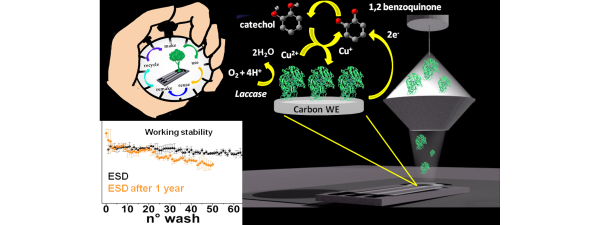The manufacture of enzymatic biosensors is an ever-expanding sector, which has attracted attention at an industrial level thanks to the possibility of exploiting the intrinsic selectivity and sensitivity of enzymatic bioreceptors. In particular, laccase-based biosensors arouse much interest due to their ability to detect highly toxic molecules in the environment, becoming essential tools in the fields of white biotechnology and green chemistry. The production of a new metal-free laccase-based biosensor with unprecedented reuse and storage perfomance has been achieved by the research group of the Institute of Structure of Matter (ISM) of the National Research Council (CNR) through the application of the electrospray deposition (ESD) methodology as an enzymatic immobilization technique. The study was conducted in collaboration with Sapienza University of Rome, the University of Foggia and the IMAA, ISMN and IGAG groups of the CNR. Electrospray ionization (ESI) was used for deposition at ambient pressure and room temperature of the enzyme laccase on a carbon substrate, using sustainable chemistry. This work published in the well-known journal of the American Chemical Society (ACS), Sustainable Chemistry and Engineering, shows how the ESD technique can be successfully exploited for the fabrication of a promising new amperometric electrochemical biosensor based on laccase enzyme, with storage and reuse capacities that has no equal. The most relevant result concerns the great performances in terms of storage that can last up to 2 months without special care, leaving the biosensor at ambient pressure and temperature and exposed to sunlight, and furthermore, the possibility of reusing the newly created sensor, 63 consecutive times and a one year old sensor subjected to redeposition, 20 consecutive times underlines the good anchoring of the enzyme thanks to the ESD immobilization technique. This result is confirmed by the comparison with the more common drop casting technique which fails to compete in terms of working stability. The absence of additional chemical substances in the immobilization phase and the peculiar performances in terms of reuse, stability over time and reconditioning of the sensor make both the process and the final product "ecological and sustainable". This ESD procedure can be extended to other types of enzymes or bioactive macromolecules with physico-chemical characteristics suitable for a system based on electrochemical transduction. Therefore it can find interesting and successful applications in biotechnology and bioengineering.
LABORATORY MDA - Dott.ssa Mattea Carmen Castrovilli


 English (UK)
English (UK)  Italiano (Italia)
Italiano (Italia)